As India celebrates Rashtriya Poshan Maah (National Nutrition Month) in September, Salome Yesudas highlights the importance of promoting food-based strategies for addressing the rising malnutrition levels in the country.
CONTEXT
Malnutrition – whether undernutrition, micronutrient deficiencies or overweight and obesity – is caused by a complex interplay of economic, social, environmental, and behavioural factors that prevent people from consuming and fully benefiting from healthy diets. The most immediate causes of undernutrition and micronutrient deficiencies are inadequate dietary intake and infectious disease. Inadequate dietary intake weakens the immune system and increases susceptibility to disease; infectious disease, in turn, increases the need for more nutrients and further weakens the immune system.
There are three underlying causes of this vicious cycle:
- lack of availability or access to food (food insecurity);
- poor health triggered by poor water and sanitation and inadequate health services; and
- in the case of children, poor maternal and child-care practices, including inadequate breastfeeding and nutritious complementary feeding; and, for adults, poor food choices.
Of course, covert forces of social and economic underdevelopment and inequality often underpin these problems. A food-based dietary diversity strategy has social, cultural, economic, and environmental benefits. Agricultural diversity not only improves production but also enhances income generation and improves accessibility. Biodiverse crops will ensure sustainable diets that are environment healthy, strengthen local food systems by producing traditional/indigenous crops, and provide fodder for livestock. Home gardening, livestock production, aquaculture, and nutrition education will empower women to improve diet quality and nutritional status of the family. All these call for strengthening nutrition-sensitive extension and some ideas in this regard are discussed here.
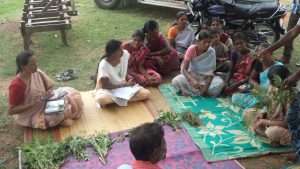 Dialogue on local greens at Jawadu Hills, Tamil Nadu
Dialogue on local greens at Jawadu Hills, Tamil Nadu
PROMOTING DIETARY IMPROVEMENT THROUGH FOOD PRODUCTION AND CONSUMPTION
A balanced diet must contain sufficient fat, protein, energy and other key nutrients if dietary vitamin A is to be properly utilized by the body. A good daily dietary mix can be made up of a staple + pulse + an animal food + green leafy vegetables or an orange-coloured vegetable or fruit. Families should be encouraged to use all these foods to make a meal. Some examples are: staple + pulse + green leafy vegetables or an orange vegetable or fruit at one meal; staple + animal food + green leafy vegetable or an orange vegetable or fruit at another meal; addition of a small amount of fat or oil can provide extra energy if none of the other foods in the meal is energy-rich.
Incorporating chicken or fish, liver or small dried fish into plant-based diets can result in marked increases in Fe and Zn absorption. Food preparation methods such as steaming and stir frying are desirable practices for increasing micronutrient bioavailability, and should be promoted accordingly. The addition of appropriate quantities of fat or oil should also be encouraged when preparing foods containing provitamin A-rich sources, in order to facilitate their absorption. The levels and bioavailability of carotenoids in green leafy vegetables, sweet potatoes, papaya, carrot and other vegetables vary greatly, and it is therefore advisable to promote the consumption of those varieties that contain higher levels.
Foods prepared with appropriate combinations of such vegetables, along with staple grains and/or pre-formed vitamin A sources such as liver or fish, enhance the vitamin A quality of the meals. Malting, fermenting, soaking and germinating of grains and legumes, all fairly typical household practices, have been shown to remove anti-nutrients such as saponins and polyphenols, thus enhancing nutrient bioavailability (Nkhata 2018).
However, lack of awareness about these different food groups, their nutrient status and how different types of processing and cooking enable or disable availability of different nutrients is a major challenge in India, and much more effort is needed, both in rural and urban areas, so as to promote nutritional understanding among the masses.
PROMOTING TRADITIONAL FOODS
The traditional food systems in India have not been researched to its full potential even though methodology for documenting traditional food systems of indigenous populations has been set out by international agencies and civil society organisations. Several indigenous populations have also been studied on their food systems. One can also refer to the AESA Blog 135 (September 2020) ‘Local Food Systems for Food and Nutrition Security: Implications for Extension and Advisory Services’ for more details on the topic.
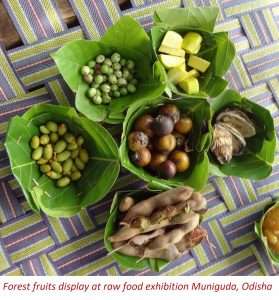 Some of the studies can be accessed from the evidence which indicates that dietary diversity is strongly and positively associated with child nutritional status and growth, even after socio-economic factors have been controlled (see the references given for further reading).
Some of the studies can be accessed from the evidence which indicates that dietary diversity is strongly and positively associated with child nutritional status and growth, even after socio-economic factors have been controlled (see the references given for further reading).
In my own research studies in different states of India I have found many varieties of foods indicating a rich diversity which is available around the year if you look at them with interest. Information related to these are given at the end of the blog (Annexure: Table 1, 2 and 3)
Recipe demonstrations; To promote traditional foods, one should organize several activities. These include:
- Recipe demonstrations;
- Cooking competitions;
- Traditional recipe books in local languages;
- Sample menu sheets based on local foods;
- Raw food displays with nutritional profiles;
- Display materials on the functions of nutrients in our body;
- Field visits to local forest/agriculture fields to identify edible plants, herbs, fruit trees, mushrooms with local elderly resource persons;
- Wall paintings of local fruits/greens/tubers;
- Wall paintings of local fish, snail, prawns, crab, etc.;
- Local radio talk shows/TV shows/newspaper articles;
- Helping to create Food Diversity Registers at panchayat level for land- and water-based edible foods (forest, streams, tanks, rivers, agriculture fields, etc.);
- Drawing food sources maps of every village and painting the same on prominent walls.
KEY ROLE OF EXTENSION IN PROMOTING NUTRITION
If the knowledge is to be translated into practice, Extension and Advisory Services (EAS) must play a very big role, and for that we need to strengthen and fine-tune their knowledge of nutrition as well as enhance their communication skills. Apart from the field staff engaged in EAS delivery in the agriculture sector, we should also enhance the knowledge on agricultural interventions that can address nutrition among the field staff of other sectors too, such as Health (ASHA workers) and Mother and Child Welfare (Anganwadi workers), and State Rural Livelihood Missions (SRLM). But to do this we need to have a flexible adaptive curricula and learning modules to support the training of these staff together with a mechanism to develop Training of Trainers (ToT) in these areas in these agencies.
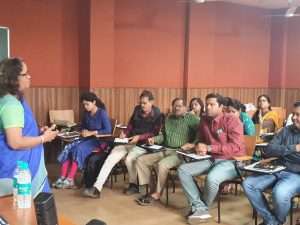 Sharing experiences on “Working with women in agri-food systems” at the IRRI-CRISP Training on Designing and Delivering Gender Responsive Extension and Advisory Services (EAS), Bhubaneswar, Odisha
Sharing experiences on “Working with women in agri-food systems” at the IRRI-CRISP Training on Designing and Delivering Gender Responsive Extension and Advisory Services (EAS), Bhubaneswar, Odisha
The real challenge is to train EAS, ICDS staff (anganwadi worker & cook), Health workers (Auxiliary Nurse-Midwife and ASHA workers), and Village Extension Workers (including para extension workers associated with the Department of Agriculture and Rural Development/SRLM) on basics of food and nutrition, emphasising local foods and their merits. In addition, sensitizing has to be also carried out at a higher level so as to stimulate cooperation from concerned authorities of these 3-4 departments. In addition, Agriculture, Horticulture, Animal Husbandry, Fisheries and other line departments also need to be sensitized to promote nutrition rich local foods and traditional varieties. Quite often each department works for meeting its own targets, thereby sometimes adversely affecting nutrition outcomes.
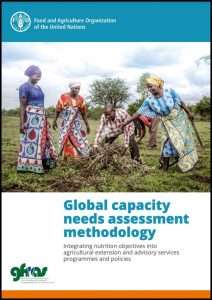 Organising short duration training programmes for in-service personnel and including the topic of nutrition-sensitive agriculture as a compulsory subject in induction trainings is a must. Outcomes of all development schemes, programmes or projects should be analysed through a nutrition lens to see how far their interventions enhance the community’s food and nutrition security or not. Often times policy makers and project designers think it will happen automatically which is not the case in most projects. Nutritional outcomes are also important as financial outcomes. Grama sabhas (meetings organised by local governments + line departments at the village level) must include food and nutrition security as part of the agenda for discussion regularly.
Organising short duration training programmes for in-service personnel and including the topic of nutrition-sensitive agriculture as a compulsory subject in induction trainings is a must. Outcomes of all development schemes, programmes or projects should be analysed through a nutrition lens to see how far their interventions enhance the community’s food and nutrition security or not. Often times policy makers and project designers think it will happen automatically which is not the case in most projects. Nutritional outcomes are also important as financial outcomes. Grama sabhas (meetings organised by local governments + line departments at the village level) must include food and nutrition security as part of the agenda for discussion regularly.
We talk so much about convergence, networking and cooperation among departments, schemes and programmes. Despite all that anaemia and malnourishment are still haunting us after all these years and programmes. A lot needs to be done in strengthening convergence so as to achieve better nutrition.
It’s time to think of locally available food-based menus to improve overall nutrition in a sustainable manner by educating mothers and adolescent girls (future mothers). Supporting small farmers and women’s groups in setting up kitchen gardens and nutrition gardens is also important. The Agricultural Technology Management Agency (ATMA) and Krishi Vigyan Kendra’s (KVKs) should play a major role in promoting these initiatives. Providing sample menus, organising demonstrations on kitchen/nutrition gardens, and customising plans according to the resources available at the farm/community level should be a priority for ATMAs and KVKs.
Strengthening Antenatal Care (ANC), immunization, parasitic control, hygiene and related activities and services for the most disadvantaged communities in rural and hilly areas is another area that deserves special attention. Regular dialogue with vulnerable groups (reproductive age women, mothers, and pregnant women) is critical so that they can understand the nutritional needs of the family and enable them to make wise food choices for the good of their children and themselves.
CONCLUSION
To achieve sustainable food and nutritional security, governments must look at several options beyond bio-fortification and industrial fortification. There are several food-based strategies for promoting dietary improvements which could come from different sources, namely, fields, farms, forests, neighbourhoods and water bodies present locally, and these can make the communities independent and responsible for maintaining the natural resources that can support year-round availability of nutritious food. Promoting a local food diversity-based strategy is the best option that we should prioritise for becoming a healthy nation.
REFERENCES FOR FURTHER READING
Burlingame B and Dernini S. 2012. Sustainable diets and biodiversity directions and solutions for policy, research and action. Rome: FAO. http://www.fao.org/3/i3004e/i3004e.pdf
McGill University. No date. Centre for Indigenous Peoples’ Nutrition and Environment (CINE). Online Resources. https://www.mcgill.ca/cine/resources
Nkhata SG, Ayua E, Kamau EH and Shingiro JB. 2018. Fermentation and germination improve nutritional value of cereals and legumes through activation of endogenous enzymes. Food Science & Nutrition 6(8):2446-58.
FAO. No date. Planning and coordinating food-based strategies. http://www.fao.org/3/x0245e/x0245e03.html
FAO and GFRAS (2021) Global capacity needs assessment methodology : Integrating nutrition objectives into agricultural extension and advisory services programmes and policies http://www.fao.org/3/cb2069en/cb2069en.pdf)
FAO 2021 Making Extension and Advisory Services Nutrition-Sensitive: The link between agriculture and human nutrition http://www.fao.org/documents/card/en/c/cb3841en)
Publications from ICMR-National Institute of Nutrition. Hyderabad, India. https://www.nin.res.in/bookrecommendations.html
Yesudas S 2020. Local food systems for food and nutrition security: Implications for Extension and Advisory Services. AESA BLOG 135. September 2020. https://www.aesanetwork.org/blog-135-local-food-systems-for-food-and-nutrition-security-implications-for-extension-and-advisory-services/
Tontisirin K, Nantel G and Bhattacharjee L. 2002. Food-based strategies to meet the challenges of micronutrient malnutrition in the developing world. Proceedings of the Nutrition Society 61(2):243-50.
Annexure
Table 1. Cultivated and uncultivated foods list (from fields, forests, neighbourhoods, and water bodies)*
| Food group | Dindori District
Madhya Pradesh |
Gadchiroli District,
Maharashtra |
Rayagada,
Rourkela, Gudari District,Odisha |
Sanga Reddy District Telangana |
| Grains | 11 | 8 | 8 | 11 |
| Pulses | 13 | 14 | 10 | 10 |
| Roots and tubers | 25 | 20 | 30 | 5 |
| Fruits | 39 | 40 | 40 | 43 |
| Greens | 34 | 33 | 32 | 30 |
| Vegetables | 22 | 23 | 28 | 73 |
| Spices | 12 | 14 | 12 | 16 |
| Oil seeds | 10 | 12 | 10 | 12 |
| Non veg | 34 | 28 | 40 | 28 |
| Fish & other foods | 17 | 25 | 20 | 3 |
| Mushrooms | 30 | 2 |
*Study areas involved a few villages from these districts. As an example, a fruit calendar is attached below (Tables 2 and 3).
Table 2. Fruit calendar – January to June (Dindori District, Madhya Pradesh, India)
| LOCAL NAME | Scientific name | Jan | Feb | Mar | Apl | May | June |
| TEMBRU | Diospyrus melanoxylon | tembru | tembru | tembru | tembru | ||
| BOR | Ziziphus mauritiana | bor | bor | ||||
| CHAR | Buchanania cochinchinensis | char | char | ||||
| BIBBA | Semecarpus anacardium | bibba | bibba | ||||
| JAMBUL | Syzygium cumini | jambu | |||||
| SITHAPHAL | Annona squamosa | ||||||
| AMBA | Mangifera indica | amba | amba | amba | |||
| IMILY | Tamarindus indica | imily | imily | Imily | Imily | imily | imily |
| JAM | Psidium guajava | jam | |||||
| PAPAYA | Carica papaya | papaya | papaya | papaya | papaya | papaya | papaya |
| KAKADI | Cucumis sativus | tembru | tembru | tembru | |||
| NIMBU | Citus limon | nimbu | |||||
| KAKAI | Floucourtia indica | bor | bor | ||||
| YERONI | Ziziphus oenoplia | char | |||||
| BEHDA | Terminalia bellirica | bibba | beda | ||||
| BEL | Aegle marmelos | bel | bel | ||||
| SHINDI | Phoenix sylvestris | shindi | |||||
| TAD | Borassus flabellifer | tad | |||||
| VARKALI | Capparis zeylanica | amba | |||||
| AQUAL | Alangium salvifolium | imily | imily | Imily | Imily | aqual | aqual |
| RAMPHAL | Annona reticulata | ramphal | |||||
| KARBHUJ | karbhuj | ||||||
| THURBUJ | Citrulus lanatus | thurbuj | |||||
| PENDRA | Not identified | nimbu | pendra | ||||
| DANGRU | Not known | dangru | |||||
| KUDA | Holarrhena pubescens | kuda | kuda | ||||
| BARGAT | Ficus benghalensis | Beda | mugna | mugna | |||
| HETI | Sesbania grandiflora | ||||||
| KHJOP | Schleichera oleosa | Shindig | khjop | khjop | |||
| PANAS | Artocarpus heterophyllus | Tad | panas | panas | |||
| UMRUN | Ficus racemose | varkali | varkali | umrun | |||
| KOVAT | Limonia acidissima | kovat | |||||
| SHELVAT | Cordia dichotoma | ramphal | shelvat | ||||
| MAHUR | Bauhinia vahlii | karbhuj | bahunia vahalia |
Table 3. Fruit Calendar – July to December
| LOCAL NAME | Scientific name | July | Aug | Sept | Oct | Nov | Dec |
| TEMBRU | Diospyrus melanoxylon | ||||||
| OVLA | Phyllanthus emblica | ovla | ovla | ovla | |||
| JAMBUL | Syzygium cumini | jambu | |||||
| JONDURILI | jondurili | jondurili | |||||
| SITHAPHAL | Annona squamosa | sithaphal | sithaphal | ||||
| AMBA | Mangifera indica | ||||||
| IMILY | Tamarindus indica | imily | imily | imily | imily | Imily | imily |
| KELA | Musa paradisiaca | ||||||
| JAM | Psidium guajava | jam | jam | jam | jam | jam | jam |
| PAPAYA | Carica papaya | papaya | papaya | papaya | papaya | papaya | papaya |
| KAKADI | Cucumis sativus | kakadi | kakadi | ||||
| NIMBU | Citus limon | nimbu | nimbu | ||||
| KAKAI | Floucourtia indica | kakai | |||||
| YERONI | Ziziphus oenoplia | Yeroni | yeroni | ||||
| BEHDA | Terminalia bellirica | ||||||
| VARKU | Variety of cucumis | varku | varku | ||||
| KUDA | Holarrhena pubescens | kuda | kuda | kuda | |||
| MUGNA | Ficus benghalensis | mugna | mugna | mugna | mugna | mugna | mugna |
| HETI | Sesbania grandiflora | heti | Heti | ||||
| PANAS | Artocarpus heterophyllus | panas | |||||
| UMRUN | Ficus racemose | umrun | umrun | ||||
| KARVAN | Carrisa congesta | karvan | karvan |
 Ms Salome Yesudas is an independent researcher who has worked very closely with different communities in many states of India. She has also worked with the Global Health Project led by McGill University, Canada, in 12 countries on all the continents on local food systems. She continues to work with marginalised communities from different regions on local food systems for food and nutrition security. (salomeyesudas@hotmail.com)
Ms Salome Yesudas is an independent researcher who has worked very closely with different communities in many states of India. She has also worked with the Global Health Project led by McGill University, Canada, in 12 countries on all the continents on local food systems. She continues to work with marginalised communities from different regions on local food systems for food and nutrition security. (salomeyesudas@hotmail.com)

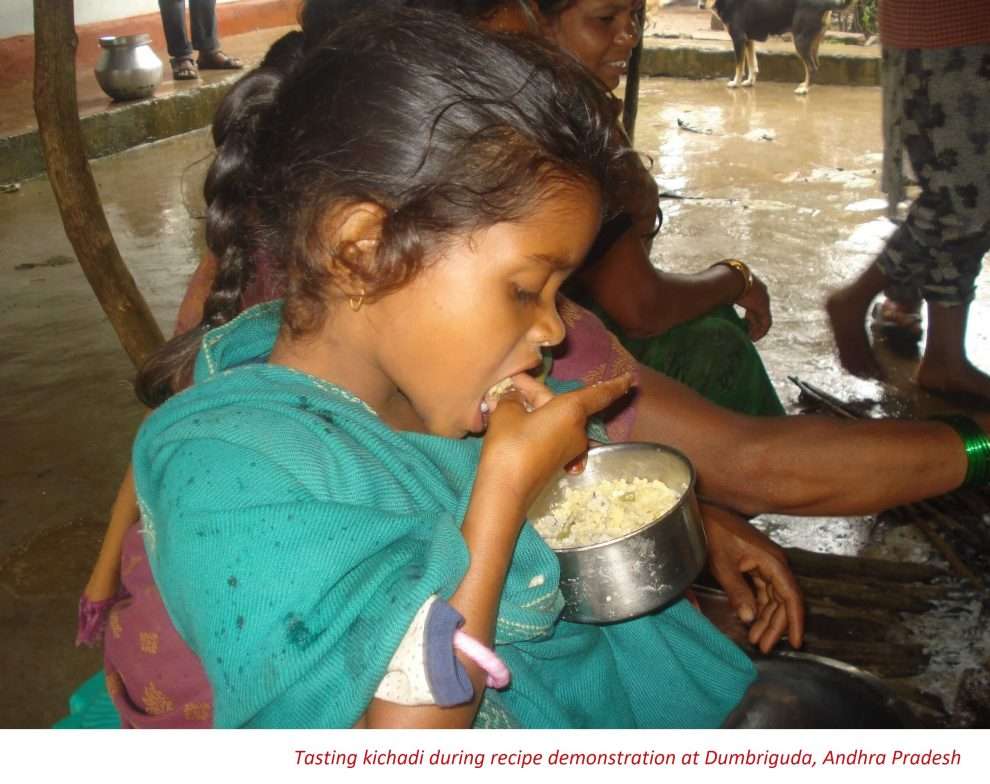

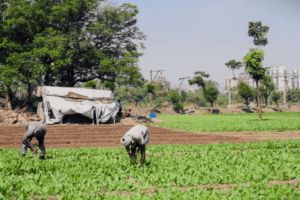

Add Comment